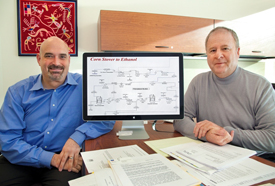Less Toxic Metabolites, More Chemical Product
The first dynamic regulatory system that prevents the build-up of toxic metabolites in engineered microbes has been reported by a team of researchers with the U.S. Department of Energy (DOE)’s Joint BioEnergy Institute (JBEI). The JBEI researchers used their system to double the production in Escherichia coli (E. coli) of amorphadiene, a precursor to the premier antimalarial drug artemisinin.
Using genome-wide transcriptional analysis, the JBEI researchers identified native regions of DNA – called “promoters” – in E. coli that respond to toxic metabolites by promoting the expression of protective genes. They then developed a system based on these promoters for regulating artificial metabolic pathways engineered into the E.coli to enable the bacterium to produce amorphadiene. (more…)

